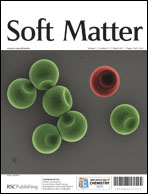Toehold of dsDNA exchange affects the hydrogel swelling kinetics of a polymer–dsDNA hybrid hydrogel
Abstract
Hydrogel-based label-free nucleic acids sensor materials using high resolution interferometric readout of hydrogel swelling changes was prepared and characterized with respect to molecular design parameters. The DNA-sensitive hydrogel comprised sensing (S) and blocking (B)


 Please wait while we load your content...
Please wait while we load your content...